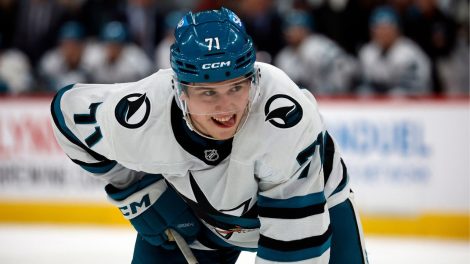The Stanley Cup is officially property of the Central Division, and taking a quick glance at the state of things in those parts, there’s an above-average chance it hunkers down there for another year or two.
That isn’t to say the Blues are on the cusp of dynasty talk — though they have all they need to make another go of it in 2019-20. It’s just the reality of how the West looks likely to shake out, with five Central clubs seemingly slotted in as legitimate contenders.
A deep playoff run from Chicago or Minnesota would be a pretty hefty plot twist (though not the Central’s first) but between established Western powers like St. Louis and Winnipeg, some talented and recently upgraded contenders in Nashville and Dallas, and the young, hungry and dangerous group in Colorado, a Central club is likely taking a swing at the Cup Final come playoff time.
That being the case, let’s break down where each of these teams stands heading into the new season:
[snippet id=4167285]
Nashville Predators
2018-19 outcome: 47-29-6, Lost to the Stars in 1st round of playoffs (6 games)
Major additions: Matt Duchene (C)
Major subtractions: P.K. Subban (D)
Best-case scenario: Matt Duchene’s presence turns the Predators’ weakness into a key strength. On his left, Mikael Granlund rediscovers the form he showed over the past few years in Minnesota. On his right, Filip Forsberg stays healthy and posts his first near-100 point campaign, as the Predators enjoy the most dominant line they’ve had yet. The newfound depth — with Ryan Johansen, Kyle Turris and Viktor Arvidsson comprising another strong top-six trio — helps Nashville claim their third-straight division title and second trip to the Cup Final in four years. Duchene puts his big-game chops on display, proving to be the game-changer Nashville’s been waiting for. Cue the parade.
Worst-case scenario: After a decade of seeing their name synonymous with deep blue lines, the Predators’ back end is brought back to earth after the loss of P.K. Subban. Injuries and lacklustre defensive play, plus slight regression from 37-year-old Pekka Rinne, turns Nashville into an all-offence juggernaut that ultimately gets bounced early in the playoffs once the time and space dry up.
Colorado Avalanche
2018-19 outcome: 38-30-14, Lost to Sharks in second round of playoffs (7 games)
Major additions: Nazem Kadri (C), Andre Burakovsky (RW), Joonas Donskoi (RW)
Major subtractions: Tyson Barrie (D), Alexander Kerfoot (C), Carl Soderberg (C), Semyon Varlamov (G)
Best-case scenario: In his first full NHL season, smooth-skating defender Cale Makar lights up the Western Conference, giving Colorado’s already-promising core an element they haven’t yet had. After drawing comparisons to Erik Karlsson from teammate Nathan MacKinnnon in the off-season, Makar makes good on the projection and piles up a 60-plus-point effort, helping lift the team’s power-play into the league’s elite. That’s enough of a bump to help the Avalanche take the next step and earn a lengthy post-season run.
Worst-case scenario: The loss of Tyson Barrie stings more than expected. Even with promising offensive defenders in Samuel Girard and Makar, the blue line’s inexperience gets the best of them more often than not. The club’s middle-of-the-pack power play falls further without Barrie, who posted the fifth-most man-advantage points among defenders one year prior, and it becomes the team’s Achilles’ Heel in the playoffs.
Dallas Stars
2018-19 outcome: 43-32-7, Lost to the Blues in 2nd round of playoffs (7 games)
Major additions: Joe Pavelski (C), Corey Perry (RW), Andrej Sekera (D)
Major subtractions: Mats Zuccarello (RW), Jason Spezza (C)
Best-case scenario: After falling just short against the champs last year, Joe Pavelski comes in and rights the ship, adding some much-needed scoring depth. He tops 35 goals for the second-straight year from Dallas’ second line, giving the Benn-Seguin-Radulov line some room to breathe. Young guns Roope Hintz and Miro Heiskanen take another step, and the Stars finish near the top of their division for the first time in four years, pushing to the Conference Final — or beyond.
Worst-case scenario: Expected to help stabilize the Stars’ depth but now asked to do so without the elite linemates he had in San Jose, Pavelski ends up under pressure to drive a line with young linemates, and falls short. Dallas defaults to banking on their loaded top line, while Pavelski takes a step back offensively. After finishing with the least goals in the division one year prior, the Stars finish only slightly better this time around, not enough to push them out of a wild-card spot, despite the aggressive off-season.
Winnipeg Jets
2018-19 outcome: 47-30-5, Lost to the Blues in 1st round of playoffs (6 games)
Major additions: Neal Pionk (D)
Major subtractions: Jacob Trouba (D), Tyler Myers (D), Brandon Tanev (LW)
Best-case scenario: After an off-season filled with critiques of his game and his desire to play a bigger role on his team Patrik Laine, aiming to prove his worth in the first of two years on his new deal, takes over the NHL. He becomes the dominant — and consistent — force he’s expected to be, his first 50-goal campaign putting him in the running for the Rocket Richard Trophy and making the Jets — already the division’s strongest offensive club — unstoppable in the West.
Worst-case scenario: The decimated blue line becomes too big a thorn in the team’s side to overlook. Dustin Byfuglien opts to move on from the NHL, and that coupled with the rest of the turnover on the Jets’ back end leaves the team with a wildly unproven defensive corps. Though Connor Hellebuyck shows well in the cage, the blue line in front of him proves too porous. The Jets’ previously division-leading goal differential plummets, and they go the way of the 2018-19 Blackhawks — dangerous offensively, disappointing defensively.
[snippet ID=3322139]
St. Louis Blues
2018-19 outcome: 45-28-9, Won Stanley Cup.
Major additions: None
Major subtractions: Pat Maroon (LW)
Best-case scenario: Gloria on repeat. This one’s a simple recipe. Best case scenario? The Blues enter 2019-20 as the team that finished off 2018-19, the one that rolled through the rest of the league en route to the Stanley Cup. They do it without the painful stint in the basement this time around, and become the second team in five years to go back-to-back.
Worst-case scenario: They aren’t able to recapture the magic. Without the underdog fuel and the push to keep climbing up the standings against all odds, the Blues fall back into mediocrity. Ever-confident Jordan Binnington comes back to earth and puts up a lacklustre follow-up season. In a division full of good teams getting better, the Blues slide and just miss the playoffs.
Chicago Blackhawks
2018-19 outcome: 36-34-12, Missed the playoffs
Major additions: Robin Lehner (G), Calvin de Haan (D), Olli Maatta (D), Andrew Shaw (RW)
Major subtractions: Artem Anisimov (C), Henri Jokiharju (D)
Best-case scenario: The kids keep rolling. Chicago’s second-line duo of Dylan Strome and Alex DeBrincat dominates in their first full season together, proving they’re the future of the club. Jonathan Toews and Patrick Kane keep doing what they’ve always done up top, Robin Lehner stabilizes things in the cage, and Chicago manages to claw their way back into the playoffs and roll the dice on Toews and Kane finding their playoff magic.
Worst-case scenario: The team falls into the same pattern as last year, and finishes with the same result. There’s plenty to cheer for up front — Toews and Kane each quietly recorded the highest point totals of their careers one year prior, and they put up hefty numbers again, but the blue line becomes too much of a question mark. They fail to shore that up, and are once again felled by subpar defence, wasting another strong showing from their top six.
Minnesota Wild
2018-19 outcome: 37-36-9, Missed the playoffs
Major additions: Mats Zuccarello (RW)
Major subtractions: None
Best-case scenario: Mats Zuccarello winds up as the missing piece, helping the club improve their division-worst goals differential from 2018-19. The return of Mikko Koivu and Matt Dumba from injury helps pull the Wild back into relevance in the West, particularly the latter, who rediscovers his Norris Trophy-worthy form from early 2018-19. The club’s underrated depth shines, and the Wild reclaim a spot in the post-season.
Worst-case scenario: More of the same. With only minor changes to a team that finished near the Western basement last season, one off-season is not be enough to turn things around, even with Dumba back in the fold. GM Bill Guerin sees young talent on the roster, but an aging core, and decides the best course is to start anew. The season becomes a write-off in pursuit of a longer-term rebuild.
[relatedlinks]








